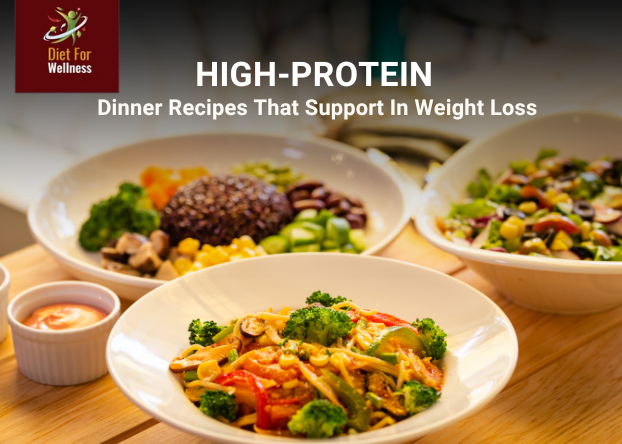High-Protein Dinner Recipes That Support In Weight Loss

Dinner plays an important role in weight management, and many weight loss efforts fail due to unhealthy or inconsistent dinner choices. If you’re trying to lose weight, it’s important to focus on a balanced intake of macronutrients, particularly protein.
Advantages of Including Protein-Rich Foods at Dinner
- Increased Satiety- Protein promotes feelings of fullness, helping to control overall calorie intake and supporting weight management.
- Muscle Repair and Growth- Protein is essential for muscle repair and growth, especially after daily physical activity.
- Stable Blood Sugar– Protein at dinner helps stabilize blood sugar levels, preventing late-night cravings.
- Boosted Metabolism– Protein supports metabolic function, contributing to efficient calorie burning.
“Eat more protein” is a common weight loss and fitness mantra, as this macronutrient is crucial for satiety and muscle building. However, the optimal type and amount of protein remain a subject of debate.
The National Research Council’s Recommended Dietary Allowance (RDA) for protein is 0.8 grams per kilogram of body weight daily for adults.
Research indicates that the primary protein source (plant-based vs. animal-based) can impact weight loss and cardiovascular health. Although animal protein may offer some benefits, such as improved lean muscle building (according to a meta-analysis), lean protein provides these advantages while minimizing calorie and unhealthy fat intake.
The Indian cuisine offers a wealth of delicious and nutritious options, incorporating lean meats, legumes, dairy, and plant-based sources, all enhanced with flavorful spices. Check out these satisfying and protein-packed Indian dinner ideas.
Indian High-Protein Dinner Ideas
- Grilled Tandoori Chicken– This classic dish is rich in protein from the chicken and yogurt marinade. Choose skinless chicken to minimize saturated fat. The yogurt adds creaminess and tang without excess calories. Serve with a side of fresh vegetables for added fiber and nutrients. Marinate the chicken breast or thighs in yogurt, garlic, ginger, turmeric, cumin, and coriander. Serve with a cucumber and tomato salad dressed with lemon juice and mint.
- Dal Tadka– Lentils are an excellent source of plant-based protein and fiber, promoting satiety and aiding weight loss. Use minimal oil and plenty of spices for flavor. Have it with whole grain like brown rice or quinoa to ensure complete protein. Cook yellow or red lentils with onions, tomatoes, garlic, ginger, cumin, turmeric, and mustard seeds. Serve with steamed brown rice or quinoa.
- Paneer Tikka Masala– Paneer (Indian cottage cheese) is a high-protein dairy option, rich in calcium and vitamins. Opt for low-fat yogurt in the marinade and sauce to reduce calories. Serve with a green salad or steamed vegetables for extra fiber. Marinate paneer cubes in yogurt and spices (garam masala, turmeric, cumin), then grill or bake. Simmer in a tomato-based sauce with onions, garlic, ginger, and low-fat yogurt instead of cream.
- Fish Curry– Fish is a lean protein source packed with omega-3 fatty acids, beneficial for heart health. Use coconut milk or tomato puree to make the curry base lighter. Include plenty of vegetables for added fiber and nutrients. Cook the fish fillets in a spicy tomato-based curry with ginger, onions, garlic, and curry leaves. Serve with whole wheat roti or steamed brown rice.
- Sprouted Moong Salad– Sprouted moong beans are loaded with protein, vitamins, and minerals. Mix them with chopped onions, tomatoes, cucumber, coriander leaves, and a squeeze of lemon juice. Serve this as a refreshing salad or wrap it in lettuce leaves for a low-carb option. Keep the dressing light with lemon juice, olive oil, and minimal salt.
- Paneer Bhurji- This easy-to-make and delightful dish is also weight-loss friendly when prepared mindfully. This paneer bhurji recipe is packed with protein-rich cottage cheese, tomatoes, and kasuri methi. Use good quality oil in moderation.
- Oats Utthapam– South Indian food lovers will enjoy this protein-packed version of the popular pancake dish. Made with oats, semolina, asafoetida, and yogurt, this delicious treat is also a healthy choice.
High-Protein Dinner Options Beyond Indian Cuisine
If you’re looking for variety beyond Indian cuisine, here are a few other high-protein dinner ideas.
- Greek Yogurt Chicken Salad- Combine diced grilled chicken breast with Greek yogurt, diced cucumber, red onion, and dill. Serve on a bed of mixed greens or whole grain bread. Greek yogurt adds protein and creaminess without excess calories. Use herbs and spices for flavor.
- Grilled Tofu with Stir-Fried Vegetables– Marinate grilled tofu in a mixture of soy sauce, ginger, and garlic. Serve with stir-fried mixed vegetables (bell peppers, mushrooms, bok choy) over quinoa or whole grain noodles. Tofu is a vegetarian protein option which absorbs flavors well. Use minimal oil for stir-frying.
- Grilled Chicken Breast with Vegetables– Seasoned with herbs and spices, grilled chicken breast paired with roasted or steamed vegetables (broccoli, bell peppers, zucchini) makes an excellent, low-calorie, high-protein meal. Choose skinless chicken and avoid high-calorie sauces or marinades. Include a variety of colorful vegetables for added fiber and nutrients.
- Stir-Fried Tofu with Rice– Tofu is a great source of protein, calcium, and iron, offering vegetarians a valuable protein option. Soy products like tofu are rich in all essential amino acids, which can support muscle building and weight loss. This dish features ginger, garlic, olive oil, shallots, and honey for added flavor.
- Quinoa Lentil Salad- This hearty salad combines the goodness of quinoa, asparagus, lentils, and pomegranate. It’s perfect for lighter meals. Drizzle with a tangy mosambi juice and mustard dressing to balance the flavors.
Some Dinner Optimization Tips That Will Come Handy
To make your dinners even healthier and support your weight management goals, consider these optimization strategies
- Lean Protein Choices– Prioritize lean cuts of meat, skinless poultry, low-fat dairy, and plant-based proteins like legumes and tofu to minimize saturated fat intake.
- Healthy Cooking Methods- Opt for grilling, baking, or sautéing with minimal oil instead of deep-frying. This significantly reduces added calories and unhealthy fats.
- Fiber-Rich Additions– Incorporate whole grains (brown rice, quinoa, whole wheat) and plenty of vegetables into your meals. Fiber promotes satiety and aids digestion.
- Limit Unhealthy Fats– Avoid heavy creams, ghee (clarified butter), and excessive oil in your cooking. Use healthier alternatives like yogurt or light coconut milk.
- Hydration– Drink water or herbal tea with your dinner to support digestion and help prevent overeating.
- Mindful Eating– Focus on enjoying your meal without distractions. Chew slowly and savor the flavors to increase satisfaction and reduce the likelihood of overeating.
